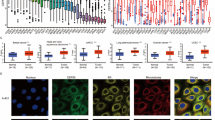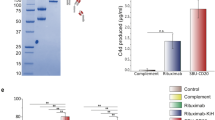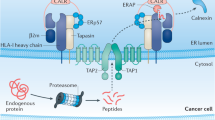Abstract
CD55 is a protein that protects cells from complement-mediated attack. 791Tgp72 is an antigen which has been used succesfully as a target for both tumour imaging and cancer vaccines. 791Tgp72 has recently been identified as CD55. Quantitative expression of CD55 in the tumour environment was therefore studied. Tumour cells showed a 4–100-fold increase in CD55 cell surface expression when compared to normal cells. Immunohistochemical staining of colorectal tumours also revealed high expression of CD55 in the stroma. To examine the source of this stromal CD55 the ability of both epithelial cells and endothelial cells to produce extracellular CD55 was measured. Tumour cell lines deposit CD55 into their extracellular matrix (ECM) in direct proportion to their cell surface expression. In contrast the ECM from HUVEC cells contained large amounts of CD55 despite expressing low levels of CD55 on their cell surface. Furthermore expression of CD55 on HUVEC cells was increased by exposure to VEGF. Although it remains unclear why CD55 is upregulated in the tumour environment its high level of expression on tumour cells and associated endothelium may explain why it is a good target for both imaging and immunotherapy. © 2001 Cancer Research Campaign
Similar content being viewed by others
Article PDF
Change history
16 November 2011
This paper was modified 12 months after initial publication to switch to Creative Commons licence terms, as noted at publication
References
Armitage NC, Perkins AC, Pimm MV, Farrands PA, Baldwin RW and Hardcastle JD (1984) Localization of an anti-tumour monoclonal antibody (791T/36) in gastrointestinal tumours. Br J Surg 71: 407–412
Armitage NC, Perkins AC, Pimm MV, Wastie ML and Baldwin RW (1985) Imaging of primary and metastatic colorectal cancer using In- 111-labelled anti-tumour monoclonal antibody 791T/36. Nucl Med Com 6: 623–631
Austin EB, Robins RA, Durrant LG, Price MR and Baldwin RW (1989) Human monoclonal anti-idiotypic antibody to the tumour associated antibody 791T/36. Immunol 67: 525–530
Buckley DJ, Chapman MA, Durrant LG, Robins RA and Armitage NC (1996) Increased expression of 791t-gp72 predicts a poor- prognosis in colorectal-cancer. Gastroenterol 110: A 497–A 497
Collard CD, Vakeva A, Bukusoglu C, Zund G, Sperati CJ, Colgan SP and Stahl GL (1997) Reoxygenation of hypoxic human umbilical vein endothelial cells activates the classic complement pathway. Circulation 96: 326–333
Coyne KE, Hall SE and Thompson ES (1992) Mapping of epitopes, glycosylation sites and complement regulatory protein domains in human decay accelerating factor. J of Immunol 149: 2906–2913
Denton GWL, Durrant LG, Hardcastle JD, Austin EB, Sewell HF and Robins RA (1994) Clinical outcome of colorectal-cancer patients treated with human monoclonal antiidiotypic antibody. Int J Cancer 57: 10–14
Durrant LG, Buckley TJD, Denton GWL, Hardcastle JD, Sewell HF and Robins RA (1994) Enhanced cell mediated tumour killing in patients immunised with human monoclonal anti-idiotypic antibody 105AD7. Cancer Res 54: 4837–4840
Durrant LG, Armstrong CM, Buckley D, Amin S, Robins RA, Carmichael JC and Scholefield JS (2000) A neoadjuvant clinical trial in colorectal cancer patients of the human anti-idiotypic antibody 105AD7, which mimics CD55. Clin Cancer Res 16: 422–430
Durrant LG, Spendlove I, Buckley DJ and Robins RA (2000) 105AD7 cancer vaccine stimulates anti-tumour helper and cytotoxic T-cell responses in colorectal cancer patients but repeated immunisations are required to maintain these responses. Int J Cancer 85: 87–93
Embleton MJ, Gunn B, Byers VS and Baldwin RW (1981) Anti-tumour reactions of monoclonal antibody against a human osteogenic sarcoma cell line. Br J Cancer 43: 582–587
Farrands PA, Perkins AC, Pimm MV, Hardy JD, Embleton MJ, Baldwin RW and Hardcastle JD (1982) Radioimmunodetection of human colorectal cancers by an anti-tumour monoclonal antibody. Lancet 2: 397–400
Farrands PA, Perkins A, Sully L, Hopkins JS, Pimm MV, Baldwin RW and Hardcastle JD (1983) Localisation of human osteosarcomas by anti-tumour monoclonal antibody. J Bone and Joint Surg 65: 638–640
Hamann J, Vogel B, Vanschijndel GMW and Vanlier RAW (1996) The 7-span transmembrane receptor CD97 has a cellular ligand (CD55, DAF). J Exp Med 184: 1185–1189
Hatanaka M, Seya T, Matsumoto M, Hara T, Nonaka M, Inoue N, Takeda J and Shimizu A (1996) Mechanisms by which the surface expression of the glycosylphosphatidylinositol anchored complement regulatory proteins decay accelerating factor (CD55) and CD59 is lost in human leukaemia cell lines. Biochem J 314: 969–976
Hindmarsh EJ and Marks RM (1998) Decay-accelerating factor is a component of subendothelial extracellular matrix in vitro, and is augmented by activation of endothelial protein kinase C. Eur J Immunol 28: 1052–1062
Jaffe EA, Nachman RL, Becker CG and Mindi CR (1972) Culture of human endothelial cell derived from umbilical veins: identification by morphological and immunological criteria. J Clin Invest 52: 2745–2775
Lanzavecchia A, Lezzi G and Viola A (1999) From TCR engagement to T cell activation: A kinetic view of T cell behaviour. Cell 96: 1–4
Maxwell-Armstrong CA, Durrant LG, Robins RA, Galvin AM, Scholefield JH and Hardcastle JD (1999) Increased activation of lymphocytes infiltrating primary colorectal cancers following immunisation with the anti-idiotype monoclonal antibody 105AD7. Gut 45: 593–599
Nasu J, Mizuno M, Uesu T, Takeuchi K, Inaba T, Ohya S, Kawada M, Shimo K, Okada H, Fujita T and Tsuji T (1998) Cytokine-stimulated release of decay-accelerating factor (DAF;CD55) from HT-29 human intestinal epithelial cells. Clin Exp Immunol 113: 379–385
Nicholson-Weller A and Wang C (1994) Structure and function of decay-accelerating factor CD55. J Lab and Clin Med 123: 485–491
Niehans GA, Cherwitz DL, Staley NA, Knapp DJ and Dalmasso AP (1996) Human carcinomas variably express the complement inhibitory proteins CD46 (Membrane Cofactor Protein), CD55 (Decay-Accelerating Factor), and CD59 (Protectin). Am J Pathol 149: 129–142
Sparrow RL and Mckenzie IFC (1983) HU-LY-M5 a unique antigen physically associated with HLA molecules. Human Immunol 7: 1–15
Spendlove I, Li L, Carmichael J and Durrant LG (1999) Decay accelerating factor (CD55): A target for cancer vaccines?. Cancer Res 59: 2282–2286
Spring FA, Judson PA and Daniels G (1987) A human glycoprotein that carries Cromer related blood group antigens on erythrocytes and is also expressed on leukocytes and platelets. Immunol 62: 307–312
Tate CG, Uchikawa M, Tanner MJA, Judson PA, Parsons SF, Mallinson G and Anstee DJ (1989) Studies on the defect which causes absence of decay accelerating factor (DAF) from the peripheral blood cells of an individual with the inab phenotype. Biochem J 261: 489–493
Tosello AC, Mary F, Amiot M, Bernard A and Mary D (1998) Activation of T cells via CD55: recruitment of early components of the CD3-TCR pathway is required for IL-2 secretion. J Inflamm 48: 13–27
Vierboom MPM, Nijman HW, Offringa R, vanderVoort EIH, vanHall T, VandenBroek L, Fleuren GJ, Kenemans P, Kast WM and Melief CJM (1997) Tumor eradication by wild-type p53-specific cytotoxic T lymphocytes. J Exp Med 186: 695–704
Vonderheide RH, Hahn WC, Schultze JL and Nadler LM (1999) The telomerase catalytic subunit is a widely expressed tumour-associated antigen recognised by cytotoxic T lymphocytes. Immunity 10: 673–679
Author information
Authors and Affiliations
Rights and permissions
From twelve months after its original publication, this work is licensed under the Creative Commons Attribution-NonCommercial-Share Alike 3.0 Unported License. To view a copy of this license, visit http://creativecommons.org/licenses/by-nc-sa/3.0/
About this article
Cite this article
Li, L., Spendlove, I., Morgan, J. et al. CD55 is over-expressed in the tumour environment. Br J Cancer 84, 80–86 (2001). https://doi.org/10.1054/bjoc.2000.1570
Received:
Revised:
Accepted:
Published:
Issue date:
DOI: https://doi.org/10.1054/bjoc.2000.1570
Keywords
This article is cited by
-
Tp53 haploinsufficiency is involved in hotspot mutations and cytoskeletal remodeling in gefitinib-induced drug-resistant EGFRL858R-lung cancer mice
Cell Death Discovery (2023)
-
Targeted delivery of siRNA using transferrin-coupled lipoplexes specifically sensitizes CD71 high expressing malignant cells to antibody-mediated complement attack
Targeted Oncology (2015)
-
Role of decay-accelerating factor in regulating survival of human cervical cancer cells
Journal of Cancer Research and Clinical Oncology (2011)
-
The impact of expressions of CD97 and its ligand CD55 at the invasion front on prognosis of rectal adenocarcinoma
International Journal of Colorectal Disease (2010)
-
Cooperation of decay-accelerating factor and membrane cofactor protein in regulating survival of human cervical cancer cells
BMC Cancer (2009)



